Problems that Matter…
Where our Inquiry Started…and never ended.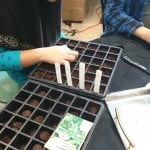
“Inquiry” seems is a hot topic in education today (although it certainly isn’t a new concept). Facilitating a true inquiry can be a challenge when students are strapped to a schedule, a curriculum or even when being assessed or monitored for their performance. It is a challenge when the classroom environment doesn’t allow for exploration or choice. Inquiry can be challenging because it isn’t predictable and it means taking risks, not knowing how long it will take and not always having the final answer.
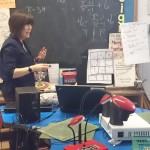 Where I co-teach with Beth Carey at the “Enrichment and Innovation Centre” (geared for Gifted Students at the HWDSB), these stipulations do not exist. A few things are important to note about our program and its uniqueness compared to a “traditional” classroom setting. First, our schedule is completely flexible. We do not have periods or subjects, there are no bell interruptions, no set lunch, no duty and no specific transition other than when to arrive and when to leave. We do not have specific seating or teaching areas. This is key because this schedule and environment allows us the time and flexibility to fully and completely immerse ourselves (teachers and students) into topics and let our natural curiosity take over. It should also be noted, that we do not start each lesson with “how it will be assessed”, but instead we leave this open-ended and students drive their own assessment through constant feedback and dialogue. With support, students monitor their own thinking and we (and they) adapt as needed.
Where I co-teach with Beth Carey at the “Enrichment and Innovation Centre” (geared for Gifted Students at the HWDSB), these stipulations do not exist. A few things are important to note about our program and its uniqueness compared to a “traditional” classroom setting. First, our schedule is completely flexible. We do not have periods or subjects, there are no bell interruptions, no set lunch, no duty and no specific transition other than when to arrive and when to leave. We do not have specific seating or teaching areas. This is key because this schedule and environment allows us the time and flexibility to fully and completely immerse ourselves (teachers and students) into topics and let our natural curiosity take over. It should also be noted, that we do not start each lesson with “how it will be assessed”, but instead we leave this open-ended and students drive their own assessment through constant feedback and dialogue. With support, students monitor their own thinking and we (and they) adapt as needed.
That is what happened today.
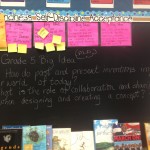 While we don’t have ‘Subjects”, we do use Big Idea questions to drive a topic. Today, for instance, we started with this question: How can LOCAL and GLOBAL citizens impact the Millennium Development Goals (MDGs)? Of course, this led to further questions: Are we working on Problems that Matter? In order to understand a problem (or perceived problem) do we need to try to live or experience that problem ourselves? What is the role in FAILURE to help us guide innovations? Of course, this is also very tightly connected to the History, Geography and Social Studies Curriculum (as well as Language, Science and Arts).
While we don’t have ‘Subjects”, we do use Big Idea questions to drive a topic. Today, for instance, we started with this question: How can LOCAL and GLOBAL citizens impact the Millennium Development Goals (MDGs)? Of course, this led to further questions: Are we working on Problems that Matter? In order to understand a problem (or perceived problem) do we need to try to live or experience that problem ourselves? What is the role in FAILURE to help us guide innovations? Of course, this is also very tightly connected to the History, Geography and Social Studies Curriculum (as well as Language, Science and Arts).
For the most part, students participated in an INQUIRY focus around the Millennium Development Goals (MDG) and the role of NGO’s, NPO’s and everything in between. Students collaboratively investigated and researched local and global initiatives and co-created a series of inquiry questions to help them develop their own humanitarian initiative. They had to first understand the topic and what exists already (and why). They c0-created a book to share a few of their ‘passions’ and what they deem as “important”.
Students created inspiring ideas. Seriously.
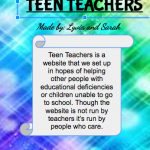 One group presented their idea, “Teen Teachers” , an idea that resembled something like a Khan Academy, except teens could join this website as ‘teachers’ or ‘students’ and learn together, as they wanted, when they wanted and what they wanted. This idea was so popular that a few other students began side conversations about how they might market this, how this could be part of their “Individual Education Plans”. Another group proposed a topic around Mental Health and Teens and suggested an organization that encouraged teens to use their musical talents, in hospitals or nursing homes, as a way to help those suffering from Mental Health disabilities. They suggested (hypothesized) that playing music for others could help the performer as much as it could help the audience.
One group presented their idea, “Teen Teachers” , an idea that resembled something like a Khan Academy, except teens could join this website as ‘teachers’ or ‘students’ and learn together, as they wanted, when they wanted and what they wanted. This idea was so popular that a few other students began side conversations about how they might market this, how this could be part of their “Individual Education Plans”. Another group proposed a topic around Mental Health and Teens and suggested an organization that encouraged teens to use their musical talents, in hospitals or nursing homes, as a way to help those suffering from Mental Health disabilities. They suggested (hypothesized) that playing music for others could help the performer as much as it could help the audience.
Another group shared an inquiry that they eventually named, “Pretty in Pink”. Similar to the “Neighbourhood Watch” initiative, this organization would encourage neighbourhoods to train, talk, discuss and learn about issues relating to Women Safety. Residents, after being trained, would get a sign/logo to post in their front window, a way to show solidarity and support and let Teens in trouble know they had somewhere safe to go.
Another group spent the afternoon learning about local farmers only to find out they had more questions then answers. Why do local products tend to cost more then imported products? Why are local farmers not supported more in schools? How can local farmers reach out to the urban communities? This group decided to form a initiative to promote local, organic and non-gmo foods and to use a crowd-sourced donation effort to bring costs down.
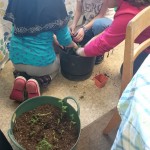 As the students collaborated, their inquiries led to further inquires and more questions. The flexibility of our day (as I noted, we do not have specified periods, recess or lunch) allowed us to veer off topic when our questions guided us in different directions. At some points, students became entrenched in their work, even when they recognized it wasn’t leading to their final outcome. The fact that we didn’t fixate on an “assessment agenda” or “evaluative criteria” freed students from the need to perform. For instance, a couple of students found themselves immersed in the Raspberri Pi’s (small computers), eventually changing their inquiry topic completely. I could write an entire chapter on the amount of problems these students had to tackle in order to get the Raspberri Pi’s running (we don’t have an ethernet internet connection). They recognized that these small computers, priced under $50.00 could solve problems relating to lack of technology access.
As the students collaborated, their inquiries led to further inquires and more questions. The flexibility of our day (as I noted, we do not have specified periods, recess or lunch) allowed us to veer off topic when our questions guided us in different directions. At some points, students became entrenched in their work, even when they recognized it wasn’t leading to their final outcome. The fact that we didn’t fixate on an “assessment agenda” or “evaluative criteria” freed students from the need to perform. For instance, a couple of students found themselves immersed in the Raspberri Pi’s (small computers), eventually changing their inquiry topic completely. I could write an entire chapter on the amount of problems these students had to tackle in order to get the Raspberri Pi’s running (we don’t have an ethernet internet connection). They recognized that these small computers, priced under $50.00 could solve problems relating to lack of technology access.
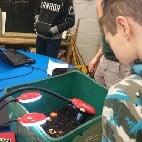 At one point, we found our Sustainable Garden group with their heads in the Worm Compost (literally) which soon became a big excitement, as student after student had to observe, touch, smell and watch these little creature do their magic (and we found thousands of little baby worms, which was very exciting). “Black- Gold or Magic Soil is what we use in our classroom garden,” we tell the students. “The worms eat our fresh fruit and vegetables and then do their job”. The students were fascinated which led to more questions about how this could be an initiative in parts of the world where fresh food wasn’t always accessible.
At one point, we found our Sustainable Garden group with their heads in the Worm Compost (literally) which soon became a big excitement, as student after student had to observe, touch, smell and watch these little creature do their magic (and we found thousands of little baby worms, which was very exciting). “Black- Gold or Magic Soil is what we use in our classroom garden,” we tell the students. “The worms eat our fresh fruit and vegetables and then do their job”. The students were fascinated which led to more questions about how this could be an initiative in parts of the world where fresh food wasn’t always accessible.
Back to our initial inquiry. Problems that Matter.
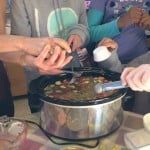 What is one artifact or symbol that can literally make students feel “at home” in the classroom? An artifact that can ease stress, encourage conversations, build relationships, have no limitations of age or ability and be completely diverse in nature?
What is one artifact or symbol that can literally make students feel “at home” in the classroom? An artifact that can ease stress, encourage conversations, build relationships, have no limitations of age or ability and be completely diverse in nature?

 Where I co-teach with Beth Carey at the “Enrichment and Innovation Centre” (geared for Gifted Students at the HWDSB), these stipulations do not exist. A few things are important to note about our program and its uniqueness compared to a “traditional” classroom setting. First, our schedule is completely flexible. We do not have periods or subjects, there are no bell interruptions, no set lunch, no duty and no specific transition other than when to arrive and when to leave. We do not have specific seating or teaching areas. This is key because this schedule and environment allows us the time and flexibility to fully and completely immerse ourselves (teachers and students) into topics and let our natural curiosity take over. It should also be noted, that we do not start each lesson with “how it will be assessed”, but instead we leave this open-ended and students drive their own assessment through constant feedback and dialogue. With support, students monitor their own thinking and we (and they) adapt as needed.
Where I co-teach with Beth Carey at the “Enrichment and Innovation Centre” (geared for Gifted Students at the HWDSB), these stipulations do not exist. A few things are important to note about our program and its uniqueness compared to a “traditional” classroom setting. First, our schedule is completely flexible. We do not have periods or subjects, there are no bell interruptions, no set lunch, no duty and no specific transition other than when to arrive and when to leave. We do not have specific seating or teaching areas. This is key because this schedule and environment allows us the time and flexibility to fully and completely immerse ourselves (teachers and students) into topics and let our natural curiosity take over. It should also be noted, that we do not start each lesson with “how it will be assessed”, but instead we leave this open-ended and students drive their own assessment through constant feedback and dialogue. With support, students monitor their own thinking and we (and they) adapt as needed. While we don’t have ‘Subjects”, we do use Big Idea questions to drive a topic. Today, for instance, we started with this question: How can LOCAL and GLOBAL citizens impact the Millennium Development Goals (MDGs)? Of course, this led to further questions: Are we working on Problems that Matter? In order to understand a problem (or perceived problem) do we need to try to live or experience that problem ourselves? What is the role in FAILURE to help us guide innovations? Of course, this is also very tightly connected to the History, Geography and Social Studies Curriculum (as well as Language, Science and Arts).
While we don’t have ‘Subjects”, we do use Big Idea questions to drive a topic. Today, for instance, we started with this question: How can LOCAL and GLOBAL citizens impact the Millennium Development Goals (MDGs)? Of course, this led to further questions: Are we working on Problems that Matter? In order to understand a problem (or perceived problem) do we need to try to live or experience that problem ourselves? What is the role in FAILURE to help us guide innovations? Of course, this is also very tightly connected to the History, Geography and Social Studies Curriculum (as well as Language, Science and Arts). One group presented their idea, “Teen Teachers” , an idea that resembled something like a Khan Academy, except teens could join this website as ‘teachers’ or ‘students’ and learn together, as they wanted, when they wanted and what they wanted. This idea was so popular that a few other students began side conversations about how they might market this, how this could be part of their “Individual Education Plans”. Another group proposed a topic around Mental Health and Teens and suggested an organization that encouraged teens to use their musical talents, in hospitals or nursing homes, as a way to help those suffering from Mental Health disabilities. They suggested (hypothesized) that playing music for others could help the performer as much as it could help the audience.
One group presented their idea, “Teen Teachers” , an idea that resembled something like a Khan Academy, except teens could join this website as ‘teachers’ or ‘students’ and learn together, as they wanted, when they wanted and what they wanted. This idea was so popular that a few other students began side conversations about how they might market this, how this could be part of their “Individual Education Plans”. Another group proposed a topic around Mental Health and Teens and suggested an organization that encouraged teens to use their musical talents, in hospitals or nursing homes, as a way to help those suffering from Mental Health disabilities. They suggested (hypothesized) that playing music for others could help the performer as much as it could help the audience. As the students collaborated, their inquiries led to further inquires and more questions. The flexibility of our day (as I noted, we do not have specified periods, recess or lunch) allowed us to veer off topic when our questions guided us in different directions. At some points, students became entrenched in their work, even when they recognized it wasn’t leading to their final outcome. The fact that we didn’t fixate on an “assessment agenda” or “evaluative criteria” freed students from the need to perform. For instance, a couple of students found themselves immersed in the Raspberri Pi’s (small computers), eventually changing their inquiry topic completely. I could write an entire chapter on the amount of problems these students had to tackle in order to get the Raspberri Pi’s running (we don’t have an ethernet internet connection). They recognized that these small computers, priced under $50.00 could solve problems relating to lack of technology access.
As the students collaborated, their inquiries led to further inquires and more questions. The flexibility of our day (as I noted, we do not have specified periods, recess or lunch) allowed us to veer off topic when our questions guided us in different directions. At some points, students became entrenched in their work, even when they recognized it wasn’t leading to their final outcome. The fact that we didn’t fixate on an “assessment agenda” or “evaluative criteria” freed students from the need to perform. For instance, a couple of students found themselves immersed in the Raspberri Pi’s (small computers), eventually changing their inquiry topic completely. I could write an entire chapter on the amount of problems these students had to tackle in order to get the Raspberri Pi’s running (we don’t have an ethernet internet connection). They recognized that these small computers, priced under $50.00 could solve problems relating to lack of technology access. At one point, we found our Sustainable Garden group with their heads in the Worm Compost (literally) which soon became a big excitement, as student after student had to observe, touch, smell and watch these little creature do their magic (and we found thousands of little baby worms, which was very exciting). “Black- Gold or Magic Soil is what we use in our classroom garden,” we tell the students. “The worms eat our fresh fruit and vegetables and then do their job”. The students were fascinated which led to more questions about how this could be an initiative in parts of the world where fresh food wasn’t always accessible.
At one point, we found our Sustainable Garden group with their heads in the Worm Compost (literally) which soon became a big excitement, as student after student had to observe, touch, smell and watch these little creature do their magic (and we found thousands of little baby worms, which was very exciting). “Black- Gold or Magic Soil is what we use in our classroom garden,” we tell the students. “The worms eat our fresh fruit and vegetables and then do their job”. The students were fascinated which led to more questions about how this could be an initiative in parts of the world where fresh food wasn’t always accessible.